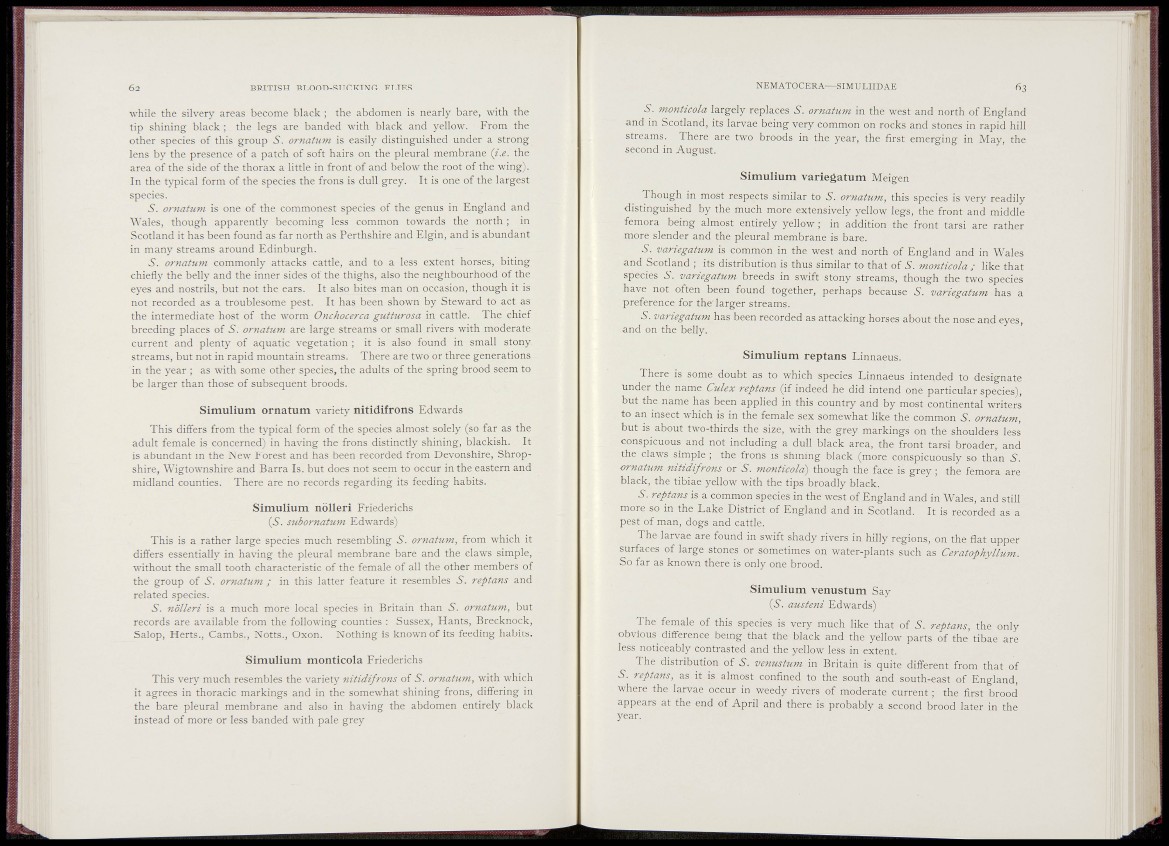
62 BRITISH BLOOD-SUCKING FLIES
while the silvery areas become black ; the abdomen is nearly bare, with the
tip shining black ; the legs are banded with black and yellow. From the
other species of this group 5. oniatum is easily distinguished under a strong
lens by the presence of a patch of soft hairs on the pleural membrane {i.e. the
area of the side of the thorax a little in front of and below the root of the wing).
In the typical form of the species the frons is dull grey. It is one of the largest
species.
5". oniatum is one of the commonest species of the genus in England and
Wales, though apparently becoming less common towards the north ; in
Scotland it has been found as far north as Perthshire and Elgin, and is abundant
in many streams around Edinburgh.
5. ornatum commonly attacks cattle, and to a less extent horses, biting
chiefly the belly and the inner sides of the thighs, also the neighbourhood of the
eyes and nostrils, but not the ears. It also bites man on occasion, though it is
not recorded as a troublesome pest. It has been shown by Steward to act as
the intermediate host of the worm Onchocerca gutturosa in cattle. The chief
breeding places of 5. orjiatiim are large streams or small rivers with moderate
current and plenty of aquatic vegetation ; it is also found in small stony
streams, but not in rapid mountain streams. There are two or three generations
in the year ; as with some other species, the adults of the spring brood seem to
be larger than those of subsequent broods.
Simulium ornatum variety nitidifrons Edwards
This differs from the tj-pical form of the species almost solely (so far as the
adult female is concerned) in having the frons distinctly shining, blackish. It
is abundant in the New Forest and has been recorded from Devonshire, Shropshire,
Wigtownshire and Barra Is. but does not seem to occur in the eastern and
midland counties. There are no records regarding its feeding habits.
Simulium nolleri Friederichs
(6". subornatum Edwards)
This is a rather large species much resembling 5. ornatum, from which it
differs essentially in having the pleural membrane bare and the claws simple,
without the small tooth characteristic of the female of all the other members of
the group of S. ornattmi ; in this latter feature it resembles 5. reptans and
related species.
S. 7i'6lleri is a much more local species in Britain than ornatum, but
records are available from the following counties : Sussex, Hants, Brecknock,
Salop, Herts., Cambs., Notts., Oxon. Nothing is known of its feeding habits.
Simulium monticola Friederichs
This very much resembles the variety nitidifrons of 5. ornatu7n, with which
it agrees in thoracic markings and in the somewhat shining frons, differing in
the bare pleural membrane and also in having the abdomen entirely black
instead of more or less banded with pale grey
NEMATOCERA- -SIMULIIDAE 63
S. monticola largely replaces 5. ornatum in the west and north of England
and m Scotland, its larvae being very common on rocks and stones in rapid hill
streams. There are two broods in the year, the first emerging in May, the
second in August.
Simulium variegatum Meigen
Though in most respects similar to 5. ornatwn, this species is very readily
distinguished by the much more extensively yellow legs, the front and middle
femora being almost entirely yellow ; in addition the front tarsi are rather
more slender and the pleural membrane is bare.
6'. variegatiim is common in the west and north of England and in Wales
and Scotland ; its distribution is thus similar to that of monticola ; like that
species variegatimi breeds in swift stony streams, though the two species
have not often been found together, perhaps because 5. variegatum has a
preference for the larger streams.
5. variegatujn has been recorded as attacking horses about the nose and eyes,
and on the belly.
Simulium reptans Linnaeus.
There is some doubt as to which species Linnaeus intended to designate
under the name Culex reptans (if indeed he did intend one particular species),
but the name has been applied in this country and by most continental writers
to an insect which is in the female sex somewhat like the common ornatum,
but is about two-thirds the size, with the grey markings on the shoulders less
conspicuous and not including a dull black area, the front tarsi broader, and
the claws simple ; the frons is shining black (more conspicuously so than 5.
ornatum nitidifro?is or ^nonticola) though the face is grey ; the femora are
black, the tibiae yellow with the tips broadly black.
5. reptans is a common species in the west of England and in Wales, and still
more so in the Lake District of England and in Scotland. It is recorded as a
pest of man, dogs and cattle.
The larvae are found in swift shady rivers in hilly regions, on the flat upper
surfaces of large stones or sometimes on water-plants such as Ceratophyllum.
So far as known there is only one brood.
Simulium venustum Say
(5. austeni Edwards)
The female of this species is very much like that of reptans, the only
obvious difference being that the black and the yellow parts of the tibae are
less noticeably contrasted and the yellow less in extent.
The distribution of vemistmn in Britain is quite different from that of
reptans, as it is almost confined to the south and south-east of England,
where the larvae occur in weedy rivers of moderate current ; the first brood
appears at the end of April and there is probably a second brood later in the
year.